mirrorlesscamera
Latest

Canon expands its mirrorless lineup with the EOS M6
In case the EOS 77D and Rebel T7i weren't enough for you, Canon has also announced the EOS M6. The company's new mirrorless camera is basically an M5 without a built-in electronic viewfinder, since it features the same 24.2-megapixel APS-C CMOS sensor, Digic 7 processor and 100-25,600 ISO. In addition to that, you get Bluetooth, NFC and WiFi for sharing photos or controlling the camera remotely via Canon's Connect app for iOS and Android. And because selfies are so important, the 3-inch LCD now tilts to help you take some beauty shots of you and your friends -- but only if the optional EVF isn't attached.
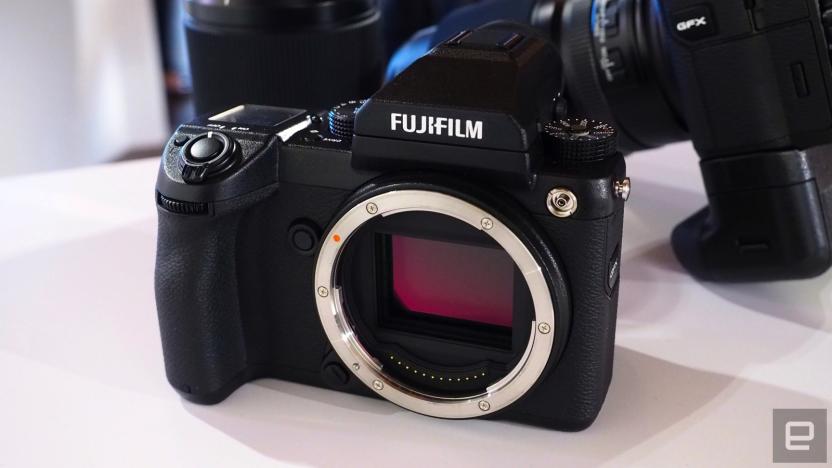
Fujifilm's GFX 50S pairs a huge sensor with a DSLR-like body
Fujifilm is kicking off 2017 with the launch of its first medium-format mirrorless camera, the GFX 50S. As we reported yesterday, the new shooter comes with a giant 51.4-megapixel CMOS sensor (43.8 x 32.9mm), the same image processor as the X-Pro2 and X-T2, as well as a 117-point autofocus system. You won't find any 4K video features here, however; the device is limited to 1080p recording at up to 30fps. Still, people are probably more interested in the GFX 50S' still photography capabilities anyway.

Fujifilm's GFX 50S medium-format mirrorless camera costs $6,500
We've known since last year that Fujifilm was working on the GFX 50S, a mirrorless camera with a medium-format sensor. But, until now, the manufacturer hadn't said how much it would cost or when it would be up for grabs. Thankfully for those of you who are interested, Fujifilm has announced that its GFX 50S is set to hit stores in "late" February for $6,500 (body-only). While that price may seem steep, it's considerably lower than a competitor like Hasselblad's X1D, which sells for roughly $9,000.

24 hours with Sony's A6500 mirrorless camera
When Sony announced the A6500 in October, it touted speed as one of the camera's main selling points. The company's new flagship E-Mount mirrorless, which hits stores later this month for $1,400 (body-only), features a 24.2-megapixel APS-C sensor with 11-fps continuous shooting. You can shoot at that rate for up to 307 frames, giving you about 30 seconds of total shooting time in a single shutter press. That's an impressive feat for any camera, let alone one this size. The A6500 also comes with in-body 5-axis image stabilization -- a first for one of Sony's APS-C shooters.
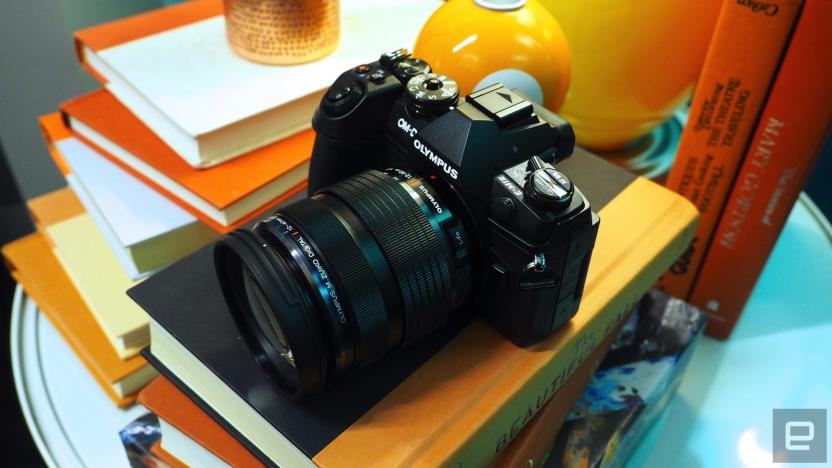
Olympus' OM-D E-M1 Mark II hits nearly all the right notes
I use two cameras on a regular basis: my iPhone 7 Plus and an Olympus OM-D E-M1 Mark I. The latter has been my workhorse since 2014, when many Engadget staffers started using it for field assignments. I've taken it to almost every press event I've attended these past two years, and the results are rarely disappointing. Still, the idea of a faster model with a better autofocus was tempting. That's where the recently launched OM-D E-M1 Mark II comes in.
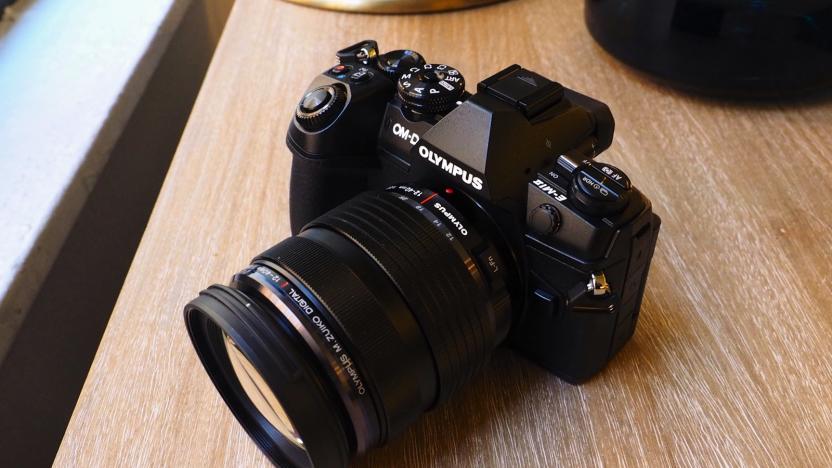
24 hours with the Olympus OM-D E-M1 Mark II
After being announced in September, Olympus' OM-D E-M1 Mark II quickly became one of the most anticipated cameras of the year. And for good reason. The new flagship mirrorless, which will hit stores in December for $2,000 (body only), is loaded with high-end specs. That includes a 20.4-megapixel Live MOS sensor (Micro Four Thirds), a dual quad-core Truepic VIII image processor, 121-point autofocus system and in-camera stabilization. Above all, though, the E-M1 Mark II is about sheer speed, featuring 18-fps shooting with continuous autofocus and autoexposure enabled, or an insane 60 frames per second if those settings are locked.

Olympus' high-end OM-D E-M1 Mark II camera arrives in December
If you've been jonesing for Olympus' ultimate take on a mirrorless camera, the OM-D E-M1 Mark II, you now know when to expect it... although it's going to cost you. The flagship cam will arrive in stores by late December for $2,000 body-only in the US, or £1,850/£2,400 in the UK for respective body-only and 12-40mm f/2.8 kit lens versions. That's a lot to shell out for a 20.4-megapixel Micro Four Thirds shooter, but Olympus is betting that the E-M1 Mark II's tricks are worth the money.

Sony's new A6500 and RX100 V cameras are all about speed
Today at an event in New York City, Sony revealed its latest compact cameras, the A6500 and RX100 V. And they have one thing in common: They're all about speed. With the A6500 flagship mirrorless, you get a 24.2-megapixel APS-C sensor with 11-fps continuous shooting, which you can fire for about 30 seconds at a time. If you do the math, that should give you a little over 300 frames in a single shutter press. The A6500 also comes with in-body 5-axis image stabilization -- a first for an APS-C-sized shooter from Sony -- as well as 100-25,600 ISO (52,000 for stills).

With the X-T2, I finally get why people love Fujifilm cameras
I've tested a handful of Fujifilm cameras over the years, but none of them have convinced me to switch from my shooter of choice, the Sony A7 II. That full-frame sensor is hard to beat. But, with the recently announced X-T2, I might be willing to reconsider. Fujifilm's new flagship mirrorless offers everything you'd want from a $1,600 (body-only) camera: sleek design, top-notch performance and, most importantly for some, a robust lens ecosystem.

Olympus' PEN E-PL8 is a stylish Micro Four Thirds camera
It wasn't too long ago that Olympus introduced its PEN-F camera, and now the company is following that up with a less expensive retro-looking model. Meet the PEN E-PL8, a Micro Four Thirds shooter with a 16.1-megapixel Live MOS sensor, a new TruePicTM VII sensor, 3-axis image stabilization and an ISO range of 100-25,600. Since it is an entry-level PEN, the E-PL8 doesn't capture videos in 4K, although you can record 1080p at 24 and 30 fps. You also have WiFi connectivity, which will let you transfer images to a smartphone or tablet through Olympus' mobile app. It'll hit stores in October for $550 body-only, or $100 for the kit with a 14-42mm lens. Not bad if you want a stylish, compact camera.

Fujifilm's GFX 50S is a mirrorless camera with a giant sensor
Fujifilm's been trying to take on its rivals by offering larger sensors for better quality pictures, but its latest system takes the cake. The new GFX 50S is the first to use the company's new G Format sensor, which Fujifilm said it fully customized and designed, and measures 43.8mm x 32.9mm. That's 1.7 times larger than the typical 35mm (aka fullframe) setup in high-end DSLRs and mirrorless cameras. And despite that huge sensor, the 50S still manages to retain a light 800 gram (body only) footprint and a size smaller than a typical fullframe DSLR. The GFX 50S will be available in early 2017, but price is still unknown.

Yi's mirrorless camera offers Leica looks for $330
Yi Technology's fledgling camera strategy goes beyond action cams. It's introducing the M1, a Micro Four Thirds mirrorless camera that promises solid performance (not to mention some familiar looks) for the money. This isn't the most advanced camera between its 20-megapixel sensor, a maximum ISO 25,600 sensitivity, and the absence of either a built-in flash or an electronic viewfinder. However, it also starts at the equivalent of $330/£253 bundled with a 12-40mm f/3.5-5.6 lens ($450/£345 with a 42.5mm f/1.8 lens), and bears more than a passing resemblance to modern Leica cameras -- it's a relatively accessible and stylish entryway into the world of interchangeable-lens photography.
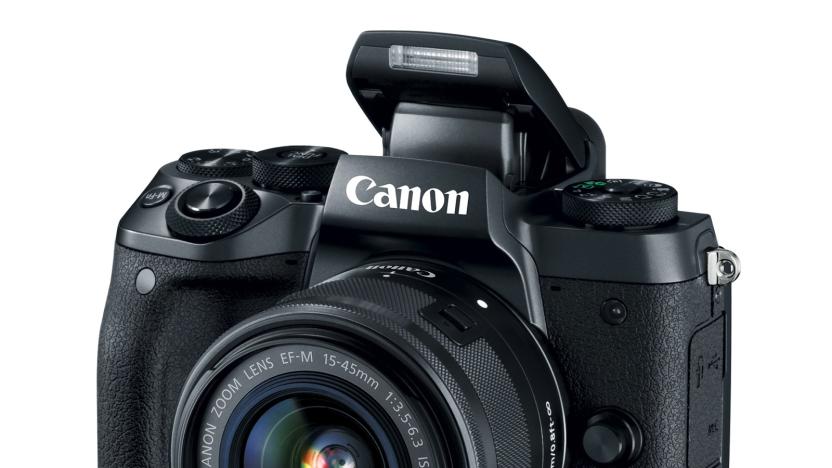
Canon's EOS M5 is a mirrorless camera with a DSLR feel
It's been almost a year since the debut of the EOS M3, arguably Canon's best mirrorless camera to date. And now the company is expanding its compact series with the M5, a high-end shooter with a DSLR feel to it. We're not saying it'll replace your DSLR, by any means, but the M3 does borrow a number of features from Canon's prosumer-focused 80D. There's the Dual Pixel CMOS autofocus, for instance, which helps you track moving subjects accurately in video mode. Additionally, you have the same 24.2-megapixel APS-C sensor and 100-25,600 ISO.

24 hours with Fujifilm's X-T2 mirrorless camera
The long-awaited Fujifilm X-T2 finally made its debut last week, bringing with it a completely revamped set of specs compared with its predecessor, the X-T1. One of the highlights of the new compact shooter is its 4K video support -- a first for Fujifilm's X-Series line of digital cameras. But there's more to like here beyond the UHD (3,840 x 2,160) recording. Inside, the mirrorless X-T2 packs a 24.3-megapixel (APS-C) X-Trans CMOS III sensor, the same one found on the flagship X-Pro2. That's complemented by the X-Processor Pro imaging chip, which the manufacturer says uses enhanced algorithms to help produce its most accurate autofocus system yet.

Fujifilm's X-T2 camera pairs a familiar design with 4K video
Based on recent conversations with Fujifilm camera users, I know many of them couldn't wait for the X-T1 successor to be announced. And well, that day is finally here. Today, Fujifilm introduced its new X-T2 mirrorless shooter, a major upgrade over the X-T1 from 2014. The X-T2 features a 24.3-megapixel (APS-C) X-Trans CMOS III sensor without a low-pass filter, which should help capture sharp, DSLR-like images. Additionally, there's an X-Processor Pro chip that, according to Fujifilm, uses improved algorithms to produce a more accurate autofocus system (325 single points, 91 zone).
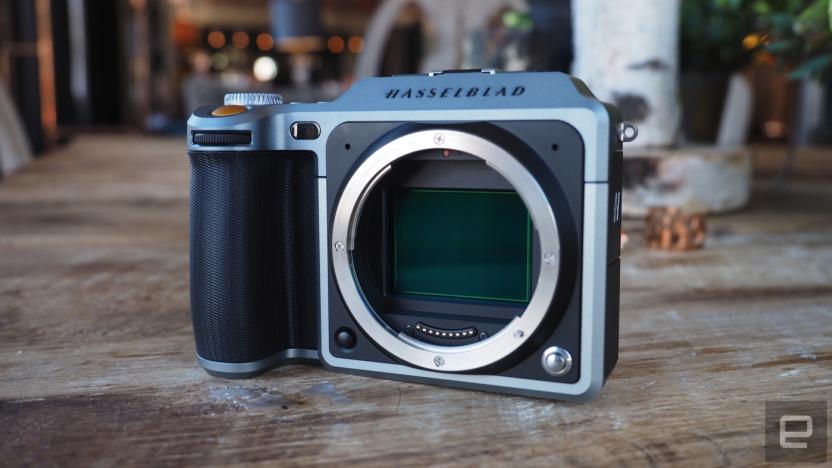
Hasselblad's X1D is a medium-format mirrorless camera
Yes, the rumors were true: Hasselblad has been working on a world's first type of mirrorless camera. Today, the Swedish company officially took the wraps off of its X1D, a compact shooter with a massive 50-megapixel, medium-format CMOS sensor. That is the largest sensor we've seen on a mirrorless camera to date, opening up the category to a whole new class of enthusiasts. What's also impressive is how light the X1D is, weighing only 725 grams (roughly 1.5 lbs) without a lens attached.
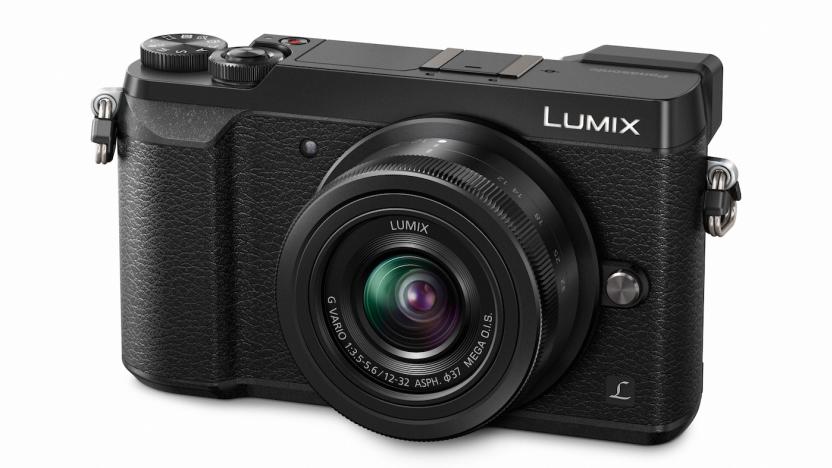
Panasonic's Lumix GX85 is a compact camera that packs a punch
The Lumix series is expanding with the GX85, an interchangeable lens mirrorless camera featuring a compact body and impressive specs. Panasonic says this shooter combines the best of its GX8 and GX7, but with some improvements over both. For starters, the Lumix GX85 sports a 16-megapixel Live MOS sensor and a new Venus Engine processor, along with a max ISO of 25,600, WiFi, up to 8-fps continuos shooting and in-camera image stabilization. Panasonic's also eliminated the low-pass filter, which should help you capture sharp and color-accurate pictures.

Sony's A6300 is a step forward for mid-tier mirrorless cameras
Sony had the right idea with its A6000: It made a powerful mirrorless camera and sold it at a relatively affordable starting price. And people loved it, with Sony claiming it's been the world's best-selling mirrorless camera since it came out two years ago. Now the company is following up with the A6300, a $1,000 (body-only) shooter with top-of-the-line specs designed for photographers and videographers alike. We've seen this formula play out well for Sony with some of its other recent models, but now it's hoping for similar results on a camera that doesn't cost north of three grand.

24 hours with Sony's A6300 mirrorless camera
Last month, Sony introduced its A6300 mirrorless camera, a follow-up to the sought-after A6000 from 2014. As expected, the company's latest compact Alpha shooter brings top-of-the-line specifications. That includes a 24.2-megapixel APS-C sensor, a Bionz X image processor, 11-fps continuous shooting, ISO up to 52,000 and 4K video in Super 35mm. In particular, Sony is emphasizing the A6300's newly developed 4D Focus, which is capable of locking in on a subject in a ridiculous 0.05 seconds. That's speedier than basically every other camera available right now.

Sony's A6300 mirrorless camera shoots 4K in Super 35mm
In similar fashion to Canon, Sony saved its best for after CES 2016. Today, at an event in New York City, the company revealed the A6300 mirrorless camera, a long-awaited successor to the A6000 from two years ago. As we're now accustomed to with Sony's latest Alpha products, the A6300 can shoot 4K, although this one does it in Super 35mm format -- which, Sony says, makes for the best video quality in any of its consumer shooters.


